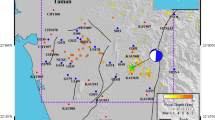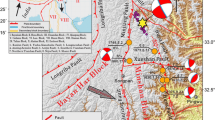Abstract
An earthquake of Mw6.4 occurred in Pishan County in Xinjiang Province, northwestern Tibetan Plateau, on July 3, 2015. The epicenter was located on an active blind thrust system located at the northern margin of the Western Kunlun Mountain Orogenic Belt southwest of the Tarim Basin. We constructed a shovel-shaped fault model based on the layered-crust model with reference to the seismic reflection profile, and obtained the rupture process of the earthquake from the joint inversion of Interferometric Synthetic Aperture Radar (InSAR) measurements, far-field waveform data, and Global Positioning System (GPS) data. The results show that the seismic fault dips southward with a strike of 109°, and the rupture direction was essentially northward. The fault plane rupture distribution is concentrated, with a maximum recorded slip of 73 cm. The main features of the fault are as follows: low inclination angle (25°–10°), thrust slip at a depth of 9–13 km, rupture propagation time of about 12 s, no significant slip in soft or hard sedimentary layers at 0–4 km depth and propagation from the initial rupture point to the surrounding area with no obvious directionality. The InSAR time-series analysis method is used to determine the deformation rate in the source region within 2 years after the earthquake, and the maximum value is ~17 mm yr−1 in the radar line-of-sight direction. Obvious post-earthquake deformation is evident in the hanging wall, with a similar trend to the coseismic displacement field. These results suggest that the Pishan earthquake has not completely released the accumulated energy of the region, given that the multilayer fold structure above the blind fault is still in a process of slow uplift since the earthquake. Post-earthquake adjustment models and aftershock risk analysis require further study using more independent data.
Similar content being viewed by others
References
Allen M B, Walters R J, Song S, Saville C, De Paola N, Ford J, Hu Z, Sun W. 2017. Partitioning of oblique convergence coupled to the fault locking behavior of fold-and-thrust belts: Evidence from the Qilian Shan, northeastern Tibetan Plateau. Tectonics, 36: 1679–1698
Bassin C G L, Laske G, Masters G G. 2000. The current limits of resolution for surface wave tomography in North America. Eos Trans AGU, 81: F897
Chaussard E, Wdowinski S, Cabral-Cano E, Amelung F. 2014. Land subsidence in central Mexico detected by ALOS InSAR time-series. Remote Sens Environ, 140: 94–106
Chen C W, Zebker H A. 2002. Phase unwrapping for large SAR interferograms: Statistical segmentation and generalized network models. IEEE Trans Geosci Remote Sens, 40: 1709–1719
Elliott J R, Elliott A J, Hooper A, Larsen Y, Marinkovic P, Wright T J. 2015. Earthquake monitoring gets boost from new satellite. Eos, 96: 14–18
Feng G, Li Z, Xu B, Shan X, Zhang L, Zhu J. 2016. Coseismic Deformation of the 2015 M w6.4 Pishan, China, earthquake estimated from Sentinel-1A and ALOS2 data. Seismol Res Lett, 87: 800–806
Gao R, Huang D D, Lu D Y, Qian G, Li Y K, Kuang C Y, Li Q S, Li P W, Feng R J, Guan Y. 2000. Deep seismic reflection profile crossing the conjunct belt between West Kunlun Orogenic belt and Tarim Basin. Chin Sci Bull, 45: 1874–1879
Hartzell S H, Heaton T H. 1983. Inversion of strong ground motion and teleseismic waveform data for the fault rupture history of the 1979 Imperial Valley, California, earthquake. Bull Seismol Soc Amer, 73: 1553–1583
He J, Vernant P, Chéry J, Wang W, Lu S, Ku W, Xia W, Bilham R. 2013. Nailing down the slip rate of the Altyn Tagh fault. Geophys Res Lett, 40: 5382–5386
He P, Wang Q, Ding K, Li J, Zou R. 2016a. Coseismic and postseismic slip ruptures for 2015 M w6.4 Pishan earthquake constrained by static GPS solutions. Geodesy Geodyn, 7: 323–328
He P, Wang Q, Ding K, Wang M, Qiao X, Li J, Wen Y, Xu C, Yang S, Zou R. 2016b. Source model of the 2015 M w6.4 Pishan earthquake constrained by interferometric synthetic aperture radar and GPS: Insight into blind rupture in the western Kunlun Shan. Geophys Res Lett, 43: 1511–1519
Jiang X, Li Z X, Li H. 2013. Uplift of the West Kunlun Range, northern Tibetan Plateau, dominated by brittle thickening of the upper crust. Geology, 41: 439–442
Li H B, Valli F, Xu Z Q, Yang J S, Tapponnier P, Lacassin R, Chen S Y, Qi X X, Chevalier M L. 2006. Deformation and tectonic evolution of the Karakorum fault, western Tibet (in Chinese). Geo China, 33: 239–255
Li Q, Gao R, Lu D, Li J, Fan J, Zhang Z, Liu W, Li Y, Yan Q, Li D. 2001. An explosive seismic sounding profile across the transition zone between west Kunlun Mts. and Tarim Basin. Sci China Ser D-Earth Sci, 44: 666–672
Li T, Chen J, Fang L, Chen Z, Thompson J A, Jia C. 2016. The 2015 M w6.4 Pishan Earthquake: Seismic hazards of an active blind wedge thrust system at the Western Kunlun Range Front, Northwest Tibetan Plateau. Seismol Res Lett, 87: 601–608
Lu R, Xu X, He D, Liu B, Tan X, Wang X. 2016. Coseismic and blind fault of the 2015 Pishan Mw6.5 earthquake: Implications for the sedimentarytectonic framework of the western Kunlun Mountains, northern Tibetan Plateau. Tectonics, 35: 956–964
Massonnet D, Rossi M, Carmona C, Adragna F, Peltzer G, Feigl K, Rabaute T. 1993. The displacement field of the Landers earthquake mapped by radar interferometry. Nature, 364: 138–142
Pan Y. 1990. Tectonic features and evolution of the Western Kunlun mountain region (in Chinese). Chin J Geol, 17: 224–232
Sandwell D, Mellors R, Tong X, Wei M, Wessel P. 2011. GMTSAR: An InSAR Processing System Based on Generic Mapping Tools. Office of Scientific & Technical Information Technical Reports
Sandwell D, Mellors R, Tong X, Wei M, Wessel P. 2013. Open radar interferometry software for mapping surface Deformation. Eos Trans AGU, 92: 234
Shan X, Ma J, Wang C, Liu J, Song X, Zhang G. 2004. Co-seismic ground deformation and source parameters of Mani M7.9 earthquake inferred from spaceborne D-InSAR observation data. Sci China Ser D-Earth Sci, 47: 481–488
Shirzaei M, Bürgmann R, Fielding E J. 2017. Applicability of Sentinel-1 terrain observation by progressive scans multitemporal interferometry for monitoring slow ground motions in the San Francisco Bay Area. Geophys Res Lett, 44: 2733–2742
Sobel E R, Dumitru T A. 1997. Thrusting and exhumation around the margins of the western Tarim basin during the India-Asia collision. J Geophys Res, 102: 5043–5063
Sun J, Johnson K M, Cao Z, Shen Z, Bürgmann R, Xu X. 2011. Mechanical constraints on inversion of coseismic geodetic data for fault slip and geometry: Example from InSAR observation of the 6 October 2008 Mw6.3 Dangxiong-Yangyi (Tibet) earthquake. J Geophys Res, 116: B01406
Sun J, Shen Z K, Li T, Chen J. 2016. Thrust faulting and 3D ground deformation of the 3 July 2015 M w6.4 Pishan, China earthquake from Sentinel-1A radar interferometry. Tectonophysics, 683: 77–85
Tong X, Schmidt D. 2016. Active movement of the Cascade landslide complex in Washington from a coherence-based InSAR time series method. Remote Sens Environ, 186: 405–415
Wang E, Wan J, Liu J. 2003. Late Cenozoic geological evolution of the foreland basin bordering the West Kunlun range in Pulu area: Constraints on timing of uplift of northern margin of the Tibetan Plateau. J Geophys Res, 108: 2401
Wang W M, Hao J L, He J K, Yao Z X. 2015. Rupture process of the Mw7.9 Nepal earthquake April 25, 2015. Sci China Earth Sci, 58: 1895–1900
Wang W M, Zhao L F, Juan L I. 2008. Rupture process of the Ms8.0 Wenchuan earthquake of Sichuan, China (in Chinese). Chin J Geophy, 51: 1403–1410
Wang W M, Zhao L F, Li J, Yao Z X. 2005. Rupture process of the Chi-Chi (Taiwan) earthquake in 1999. Chin J Geophys, 48: 143–159
Wen Y, Xu C, Liu Y, Jiang G. 2016. Deformation and source parameters of the 2015 Mw6.5 earthquake in Pishan, Western China, from Sentinel-1A and ALOS-2 data. Remote Sens, 8: 134
Wu C, Li J, Liu J, Hu W, Wu G, Chang X, Yao Y, Xiang Z. 2017. Pishan 6.5 earthquake of Xinjiang: A fold earthquake event in the West Kunlun piedmont (in Chinese). Seismol Geol, 39: 342–355
Xiao A, Yang S, Chen H, Jia C Z, Wei G. 2000. Structural characteristic of thrust system in the front of the West Kunlun Mountains. Earth Front, (S2): 128–136
Xu X, Sandwell D T, Tymofyeyeva E, Gonzalez-Ortega A, Tong X. 2017. Tectonic and anthropogenic deformation at the Cerro Prieto geothermal step-over revealed by Sentinel-1A InSAR. IEEE Trans Geosci Remote Sens, 55: 5284–5292
Yao Z X, Ji C. 1997. The inverse problem of finite fault study in time domain (in Chinese). Chin J Geophy, 40: 691–701
Zhang G, Shan X, Zhang Y, Hetland E, Qu C, Feng G. 2016. Blind thrust rupture of the 2015 M w6.4 Pishan earthquake in the Northwest Tibetan Plateau by joint inversion of InSAR and seismic data. J Asian Earth Sci, 132: 118–128
Zhang Y, Xu L S, Chen Y T. 2013. Rupture process of the Lushan 4.20 earthquake and preliminary analysis on the disaster-causing mechanism (in Chinese). Chin J Geophy, 56: 1408–1411
Acknowledgements
The far-field waveform data were provided by IRIS, and the SENTINEL-1A image data were provided by the European Space Agency (ESA). The figures in this article were generated using GMT software. The authors would like to thank the anonymous reviewers of this manuscript and the scientists whose work we have referenced herein. This study was supported by the National Natural Science Foundation of China (Grant Nos. 41474036 & 41174037) and the 13th Five-year Informatization Plan of Chinese Academy of Sciences (Grant No. XXH13505-06).
Author information
Authors and Affiliations
Corresponding author
Rights and permissions
About this article
Cite this article
Wang, X., Wang, W., Zhao, J. et al. Rupture process of the 2015 Pishan earthquake from joint inversion of InSAR, teleseismic data and GPS. Sci. China Earth Sci. 61, 1467–1481 (2018). https://doi.org/10.1007/s11430-017-9230-8
Received:
Revised:
Accepted:
Published:
Issue Date:
DOI: https://doi.org/10.1007/s11430-017-9230-8




